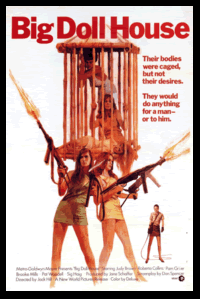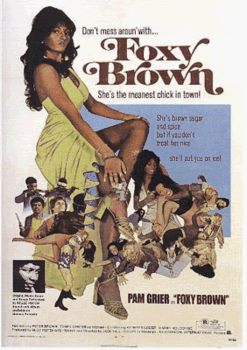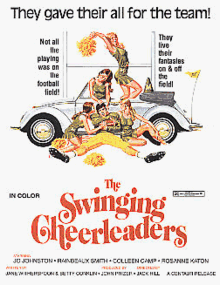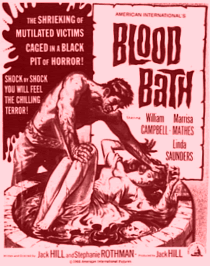
|
FILMOGRAPHY 1969
1971
1972
1973
1974
Swinging Cheerleaders
1975
1983
The Wasp Woman
(TV version)
(1960)
|
|
by Nathaniel Thompson (originally conducted in 2000) MONDO DIGITAL: You're one of the few directors whose body of work has been almost entirely released on DVD and stayed in print. How much input have you had in getting them released? JACK HILL: Well, this might shed some light on why MGM is struggling: they took over the Orion library, so I called them and said if they were going to do DVDs for Coffy and Foxy Brown, I'd be happy to do commentary, and Quentin Tarantino said he'd love to do it with me just for the fun of it. They said they'd get back to me, and I never heard back from them -- so now if they get out, they'll be without commentary. It's a shame because DVD purchasers like that; you could have better sales with something like that. On the other hand, I just did a new commentary for The Swinging Cheerleaders. That was a great looking print! We took it off the negative. Anchor Bay's a real stickler for quality; they only want to get the best possible elements. They have it out on tape also. What about the Switchblade Sisters DVD? The laserdisc is great, and the DVD was announced a long time ago. That's Buena Vista, so I guess they're just really slow. They released the laserdisc without the trailer, which was a pretty serious oversight. Things like that aren't major titles that some people think are bothering with, I have a hunch, so they don't realize how much of an audience there really is for those films. Everything that was on the laserdisc will be on the DVD, and I believe the trailer will be on the DVD because I specifically brought it to their attention. They said they would make sure it was. That's a shame because the DVD market is really hot now, and it's going to cool off very quickly if it gets saturated. There always seems to be a demand for good releases, though. Well, Spider Baby is coming out next month on DVD. Will that have more extras than the laserdisc? Yeah, several months ago I acquired all of the remaining original release prints of Spider Baby that had been stored in a storage facility in Santa Monica for thirty years. I went through them to salvage as many good prints as possible, about fourteen of them, and many of them were in very poor condition and unusable. I sorted them out and spent a lot of time going through them, grading them, and cannibalizing them to get prints that had pieces missing. Then I discovered that one of those prints was the original laboratory answer print, which was much finer than the release print quality. It had six minutes of footage that the distributor had cut out of it, probably in a way to the movie's benefit. It kind of moved it along faster at the time, but my feeling is that the movie is such a cult classic now that people are familiar with it and would like to see more of their characters on the screen. Right now we're arranging a premiere at the NuArt [in Los Angeles], so it's already in their catalog. They're calling it the "director's cut," which it is, and there will be a lot of midnight screenings of that all over now. Image, who had done the laserdisc, was going to put it out on DVD, and when I discovered this I called them and asked if they could hold it. What they're doing is putting the reel with the missing footage on as a separate item on the DVD, so theoretically you should be able to click it into the movie where it originally belonged. This way you can look at the missing footage and decide for yourself whether it helped or hurt the picture. So the footage is completely continuous? Yes, it's more exposition dialogue, a few more things with the kids that were cut out. All the cuts were made within a ten minute section. Anchor Bay will issue a VHS version of the complete cut as well. Were you ever consulted for any of the DVDs being released by Roger Corman, like Big Doll House? No, but I'm now in discussions with him now about doing commentary for The Big Bird Cage. Most of your films have been released open matte on home video. How do you feel about presenting them this way, or is there an aspect ratio you prefer? I shot all of my films, except Coffy and Foxy Brown because I didn't have that kind of control over them. They shot those two at 1.85:1, and the cameraman framed them in such a way that you really have to pan and scan it in order to see everything. I always framed my films where I had that control in such a way that everything you needed to see was within the television frame. Theatrically I prefer 1.66:1 because you just get more there on the screen, but if the theater prefers 1.85:1, they can do it. I always figured that in the future, nobody would really know what kind of aspect ratios people would be stuck with, so I framed it so that at a minimum you'd see everything you needed to see. You were involved in that complicated situation involving the film Operation Titian, which was splintered into Blood Bath and Portrait in Terror [detailed in Video Watchdog magazine]. How was that project explained to you in the beginning? It started out as a Yugoslavian movie, kind of a detective story, not a horror movie. Roger asked me to go through it and see what I could salvage out of it, then shoot additional footage to make a horror movie out of it. I wrote the script, shot it, and put it together. Roger was out of the country at that time, and his brother felt that the look of the footage wouldn't really intercut. I think that was a big mistake, because once you actually transferred it all to a new negative and printed it, then it would have matched. However, at that time, he had hired Stephanie Rothman and her husband as well. By that time he felt he could take the original Yugoslavian movie and release it to TV to make money on it, then take the footage I had shot and pad it out into a full length movie and have another film instead of just one. I was off doing something else, and so he asked Stephanie to take what I had shot and write additional material to pad it out into a full length movie. She was into vampires, and the original movie had nothing at all to do with vampires - just a psychopathic killer type of story, and she turned it into a vampire movie, which I thought just totally ruined it. Then after that you did a similar service with the four Boris Karloff films done wiht Mexico. We shot some in Hollywood, then the films were finished in Mexico. How much did you shoot yourself? What was the schedule? Well, this is what I had learned from Roger Corman. I had to design the scripts in such a way that all of Karloff's scenes could be done in Hollywood, with a minimum of other shooting on the same sets because the sets could not be duplicated in Mexico. In other words, they had to be written so that Boris would appear only in a minimum number of sets with little other work to be done in the same place, because otherwise Boris' time would be used up waiting for other people. We shot all of Boris' scenes in four weeks, and it was really a disaster in some ways because the whole idea was insane in the first place. It's just wacko to do a project like that, four pictures back to back, to be finished later! I was supposed to go to Mexico to finish them because I had everything in my head exactly how it was going to be done. We went over budget and over schedule because the Mexican actors weren't appearing when they were supposed to, and the wrong ones came at the wrong time. It was total chaos. The producer was in financial trouble, and I thought it should have been easy for him with four Boris Karloff pictures to raise the money to finish them properly, but I guess he also had a problem with the Mexican unions when I was not allowed to come shoot down there. The producer died of a heart attack, which is no wonder! I never heard any more about it, and only many years later did I find out that the pictures had been finished and were in fact on video. To this day I haven't seen all of them because what after what I saw, I didn't have the heart to look at the rest of them. Rhino just reissued them as a box set on video. It looks really slick, so I can only imagine what people will think when they buy them. I wonder who owns them now? Originally Columbia was involved because they had a Latin American department. Maybe they're public domain now. You'd mostly been working for Roger Corman up to that point, so how did you switch over? At that time I was actually going under contract to Universal, and I took a leave to do the Karloff pictures because I was committed to them before I signed with Universal. It all turned into a total Kafkaesque nightmare. I had already done Pit Stop before that, which was for Roger, and Spider Baby, which was totally separate. Then in 1969 I started working on Big Doll House. That was quite a pioneering film, an over the top, feminist women in prison movie. I knew that they were looking for a women in prison movie because there was a movie called 99 Women, which had done surprisingly good business. They felt there was a market there. This writer [Don Spencer] had a script called The Big Doll House, a women in prison movie, and I thought it was very good. I took it to Roger, and he purchased it. Then I had to go off to Switzerland to work on a film called I, a Groupie, which was a disastrous experience as well. While I was away, Stephanie Rothman and her husband had taken over at New World because Roger was out of the country shooting Richthofen & Brown in Ireland. They came in and showed me a rewrite of the script they had done, and it was a totally different script. It had no resemblance to the original script at all, just the same title. I read it and thought it was really awful, and I had a meeting with Stephanie's husband where I told him some of my feelings about the script. She immediately got on the phone to Roger in Ireland, where he was secluded in a hotel room not answering the door because a stunt pilot had gotten killed in the movie. She told him that I was uncooperative and she couldn't work with me, because she really wanted to direct the movie herself, so he told her to just go ahead and take me off the picture. Of course I immediately contacted Roger's attorney, and she explained to Roger that he had a deal with me and they couldn't just do that. When Roger returned, we basically had a discussion about the script. I incorporated most of the first draft and then did a major rewrite on it myself in the Philippines while we were waiting for the preparations to be done. Since I was many thousands of miles away from everyone, I just did what I wanted to do, shot the picture, and sent it back to them. Roger was very excited and knew that he had a big hit in his hands. He didn't know how big, though-it turned out to be the most successful independent movie made up to that time. Was the last line of the film dubbed in later where Judy Brown winds up being taken back to prison? I only found out about that recently; it was put in for some later release apparently, though I don't know why. It sounds really strange in the film! I hope that people who see the movie will realize that it was added in later. That's not my voice, but I'm the guy in the car who picks her up, of course. Was Big Bird Cage reworked from the same script? Basically they wanted to have me just do a sequel, but in the year intervening between the two films, every independent company tried to quickly produce their own similar movies and get them out on the market. Even Roger had another one. The actresses stayed over in the Philippines, and he had another script knocked out very quickly, called Women in Cages. It wasn't bad, actually; they had a fine cameraman, and Sergio Santiago directed it. By that time it was time to do a takeoff on it since there were so many movies in between, so I wrote Big Bird Cage mostly as a comedy in mind. The original Big Doll House script was actually used twice more, and then I believe it was used pretty much as the original script in Jonathan Demme's movie [Caged Heat]. I think that's the closest to the original script. You can take a script and get someone to rewrite it, and they change it so much that you end up with two different scripts. So you've got the original script and somebody can rewrite that again and come up with still another script. That's what happened. And they all turned out to be good! Then you wound up with Pam again for Coffy and Foxy Brown. What kind of working relationship did you have together? Professional. I basically got to know her personality very well and wrote her scripts for her. I worked very closely with her; I had some conversations with her where she gave me some good ideas about things she could personally do as an actress, and I just got a feeling. So I wrote to suit her, and that's why I think Coffy was the most effective movie of hers, out of any of them. They didn't give me much time with Foxy Brown; they weren't really into sequels. It was originally called Burn, Coffy, Burn, and at the last minute when we were in preproduction the sales department pronounced that sequels weren't doing very good business. They didn't want anymore sequels then, which was a totally idiotic thing to do because this was a highly successful film that created a real character. We could have had a franchise there, but the sales department is in command in situations like that. They simply suggested changing the name of the character to Foxy Brown, and everything else was the same. It wasn't the huge phenomenal success that Coffy was, but it did very well. In my mind it wasn't as good a script; I tried to just make it more outrageous because they didn't give me the time to work out a really great plot like the original one. Also when you have to write a sequel to your own movie, you tend to have used up all your best ideas on that particular subject matter. You end up trying to rework the ideas you had rejected as not being quite that good. Then all the films she did after that didn't have that feel, partly because I think she was in envy of Tamara Dobson [Cleopatra Jones] and wanted to be glamorous, wearing nice clothes, instead of being down and funky the way I had her character played. That wasn't really what the audience liked. The other films she did after that didn't really make it because the writers didn't write the scripts for her and didn't have a sense of her personality, which was too bad. You can tell simply by seeing how much Coffy and Foxy Brown are revived, while Sheba, Baby gets pretty much ignored. Foxy Brown in particular has taken off now. It's strange; that's become the more popular cult favorite over the years, I guess because it's just so totally outrageous. Quentin Tarantino probably pushed that along with Jackie Brown, too. Did you have involvement with that film? Well, I visited the set! How did you meet Quentin to begin with? They were having an AIP retrospective at the NuArt theater, and they were showing Coffy. They'd asked me to come down and introduce the films I had done there, and somebody introduced me to Quentin Tarantino. I'd heard the name but hadn't seen any of his films. I'd heard that Pulp Fiction had won at Cannes. He had his hands full of posters and soundtrack albums from my films that he wanted me to autograph, and he was just really enthusiastic and told me how much he liked my dialogue. He quoted a line of dialogue from Coffy as being such a great line of dialogue, and I was immediately struck because it was a particular line of dialogue that the average person wouldn't notice as being particularly important. It works on an inner level, and I had given a lot of thought to it - an extremely important line. I was impressed because he'd caught that and was very astute. Taken out of context, the line doesn't mean too much; in the final scene of the movie, she talks about how she feels like she's been in a dream for the past three days, she's still in the dream, and she could easily kill him. Those films still hold up. Foxy Brown with an audience today is a great experience. It might be even better if I'd had a little more control over the wardrobe! But maybe that's what people like about it. All the Huggy Bear clothes. I guess that's part of the charm of it. I did have control over the wardrobe in Coffy, though. Once Pam became a star she got to wear whatever she wanted, but I put her in clothes that would draw your eye to her face instead of to a lot of flowers and colors all over the place. You also worked constantly with Sid Haig, who went through some amazing transformations in your films. What kind of relationship did you have with him? I met him when I was doing my student film at UCLA ["The Host"]. My mentor there, Dorothy Arzner, a great woman director from the '30s and '40s, was coaching at the Pasadena Playhouse. She recommended him for my student film, and that's where I met him. We got to be great friends, and I admired his talent and his versatility so I wrote roles for him in almost every film I did. Then he got too expensive for me! Your following films were two wild feminist genre movies, Swinging Cheerleaders and Switchblade Sisters, both of which are conceptually outrageous movies. How much control did you have over those? Swinging Cheerleaders and Switchblade Sisters were done with John Prizer, a fellow I'd met at AIP. He was producing a movie called Rape Squad while I was at AIP. Rape Squad was a script they'd offered to me, and I just said that I would have to do a pretty major rewrite on it. They didn't like to hear that, so they hired my assistant director on Foxy Brown. They didn't want to have to pay me for a rewrite and thought I wanted the money, thinking the script was just fine, but they didn't realize that it was undirectable. There were things written on the paper you couldn't do on the screen. Unfortunately they didn't know the difference between a director and an assistant director, so he lasted about two days. They had to get Bob Kelljan, who was an experienced director, to come in, and he and John Prizer had to rewrite every day of shooting the night before. Bobby Kelljan saw it immediately, and the picture wasn't a successful movie. So John gave me an assignment to do this movie for a Frank Marino, who had been Roger Corman's sales manager and wanted to go on his own. He said that with my name and the title of Swinging Cheerleaders, he could finance the picture from the distributors. I said that sounded good to me, and John came up with the basic premise of the story. I got David Kidd, a very fine writer and close friend of mine, to rough out a first draft on it just to get something on paper. Then I rewrote that as we went along. It's basically the product of the three of us. Then with Switchblade Sisters, John hired a writer named Francis X. Maier, who interestingly enough today is the editor of the two major Catholic newspapers and works for the archdiocese. I'm sure he has mixed feelings about having done this movie, but he's a real talented guy. Then I did some rewriting when we started shooting. Basically those were both highly collaborative efforts. How do you feel about Switchblade Sisters after it received a belated following a few years ago in theaters? I don't know what to make of it! Critics are calling it postmodern, ahead of its time, a manifesto. At the time the movie just didn't really work. I think the advertising campaign was all wrong for it and made it look like a '50s gang movie instead of being the rather sophisticated film that it is, with a sense of humor. It actually lost money. Now audiences respond to it much more strongly than they did at the time it was made. How much subtext did you expect people to pick up, particularly in those two films? There's a lot of gender and political shading going on. I've always tried to emulate Shakespeare in my own way, in that I tried to make a film that would play to the groundlings and also have a solid intellectual substance behind it that other people can appreciate on any different level. I think the proof is in the pudding that people say they like to see most of my films over and over again and see new things in them with every viewing, which is the greatest compliment I could possibly have. At the time they were made, they were just considered exploitation movies and serious critics didn't even go to see them. For example, the LA. Times critic who reviewed Coffy went to see it in a drive-in theater and talked about how all the people there honked their horns after every bloody killing and dirty line in the script. That was the attitude the reviewers had to those films at the time, and now they're treated with great respect because people do see things they weren't looking for in those days. ------------------------------------------------------------------------------------ RESPONSE AND CORRECTIONS FROM DIRECTOR STEPHANIE ROTHMAN How should a filmmaker respond to unintended errors or willful distortions about one's work and behavior that appear on the Internet? Future historians will look to the Internet as a rich source of information, so when what is said is false, it is important to correct the record. Allegations that Jack Hill made about my behavior in this interview with him are false. Fortunately, while more than thirty years have passed, the people involved are still alive, and I have contacted them and compared our memories of this episode to verify that what I am about to describe is accurate. They are: New World Picture's Story Editor Frances Doel, and my collaborator, and husband, Charles Swartz. The interview contains three significant errors. 1. Jack Hill starts by alleging that "This writer [Don Spencer] had a script called The Big Doll House, a women in prison movie, and I thought it was very good. I took it to Roger and he purchased it." FACT: This is demonstrably wrong. The original script of The Big Doll House that Roger purchased was written by James Gordon White, not by Don Spencer. Roger Corman still has a record of the purchase agreement, dated June 6, 1970. 2. Jack Hill then goes on to claim that Charles Swartz and I rewrote the original script. "I read it and thought it was really awful," he says, "and I had a meeting with Stephanie's husband where I told him some of my feelings about the script." FACT: Neither Charles nor I ever rewrote the script, nor did we have any desire to. During the summer of 1970, we had our hands full getting the postproduction work completed on a film of our own, The Student Nurses, which we had just finished shooting. In 1970, we were members of the Writers Guild of America and all the writing we did was done under the Guild's jurisdiction. If we had actually written a draft of the script, as Jack Hill alleges, the Guild would have a record of its sale. No such record exists. Here is what did happen. At the beginning of the summer, before Roger Corman left for Ireland to direct his film Von Richthofen and Brown, he asked Charles and me to supervise all of New World Pictures' production in his absence. He had just purchased James Gordon White's screenplay of The Big Doll House and he wanted us to get a new screenplay written while he was gone. Roger, Charles, and I discussed some new story ideas that we all thought would improve it. Since Jack Hill had brought the script to him, Roger suggested that Charles, New World Pictures' story editor Frances Doel, and I work out a new story line with Jack, from which Jack could write a revised screenplay. However, he gave us the option of getting another writer if we could not agree with Jack on a story. When the three of us met with Jack, he rejected our story proposals and we jointly concluded collaboration was not possible. We then plotted a new story line ourselves and hired Don Spencer to do the rewrite. This was Don's first involvement with The Big Doll House. When Roger Corman returned from Ireland, Don Spencer's rewrite was waiting for him. 3. Jack also claims that I called Roger Corman in Ireland and, in Jack's words, "I told him that I was uncooperative and she couldn't work with me because she really wanted to direct the movie herself, so she told him to go ahead and take me off the picture." FACT: What happened was just the opposite of what Jack claims. I neither talked nor wrote to Roger while he was in Ireland. And I never told him I wanted to direct the film. What Jack may not know is that as soon as Roger returned from Ireland, he asked me if I would be interested in directing The Big Doll House and I told him I would not. I appreciated his offer, but I had another project in mind that I wanted to make. That was the last I had to do with The Big Doll House. Roger then turned the project over to Jack. I have not seen Jack Hill in over thirty years. We only met a few times in the company of other people and the only time we spoke at any length was during the single story meeting I have described. I know that time and forgetfulness can, on occasion, cause all of us to have a distorted memory, but Jack's version of these events is more than distorted, it never happened. August 2, 2001
|



 f
f